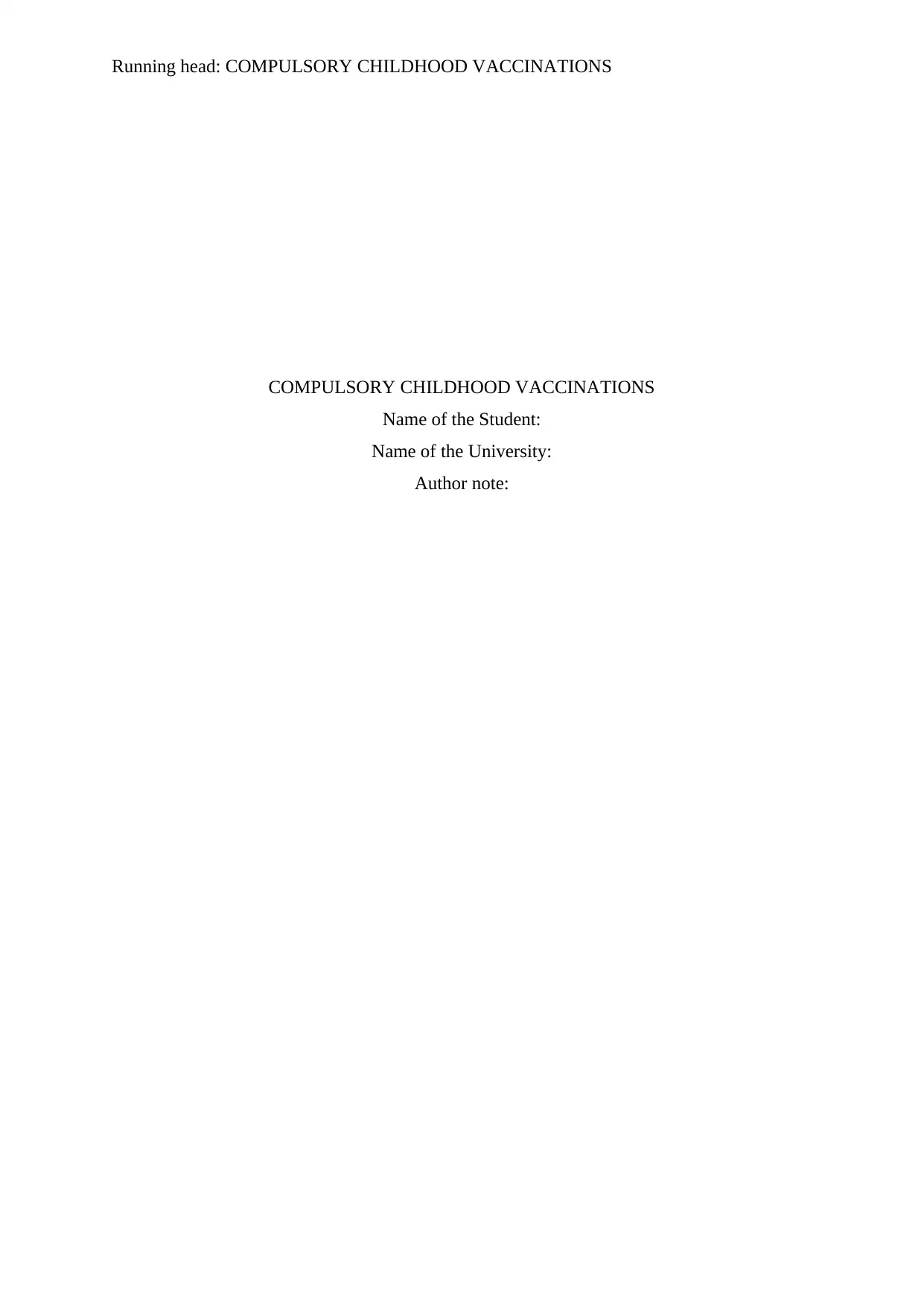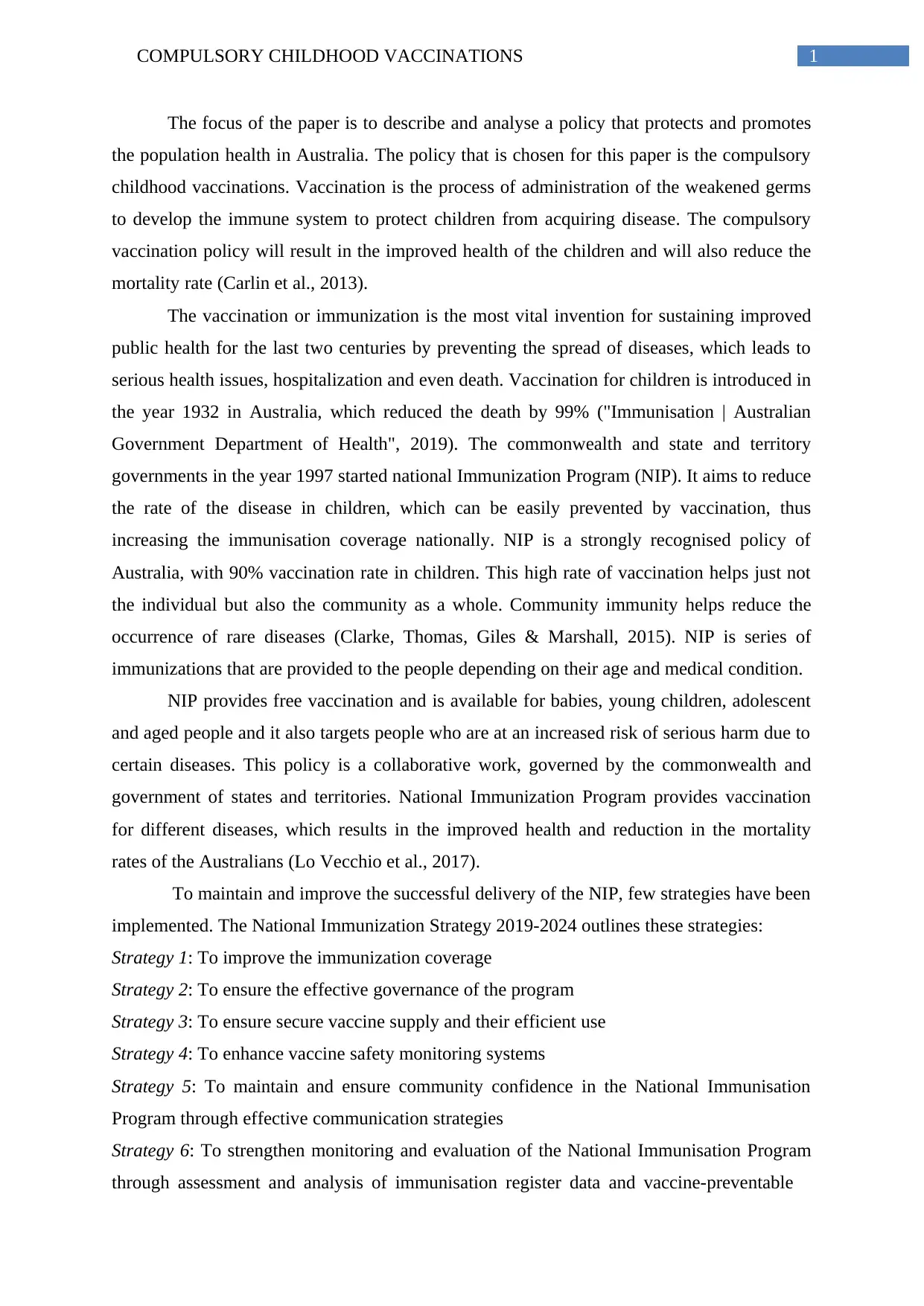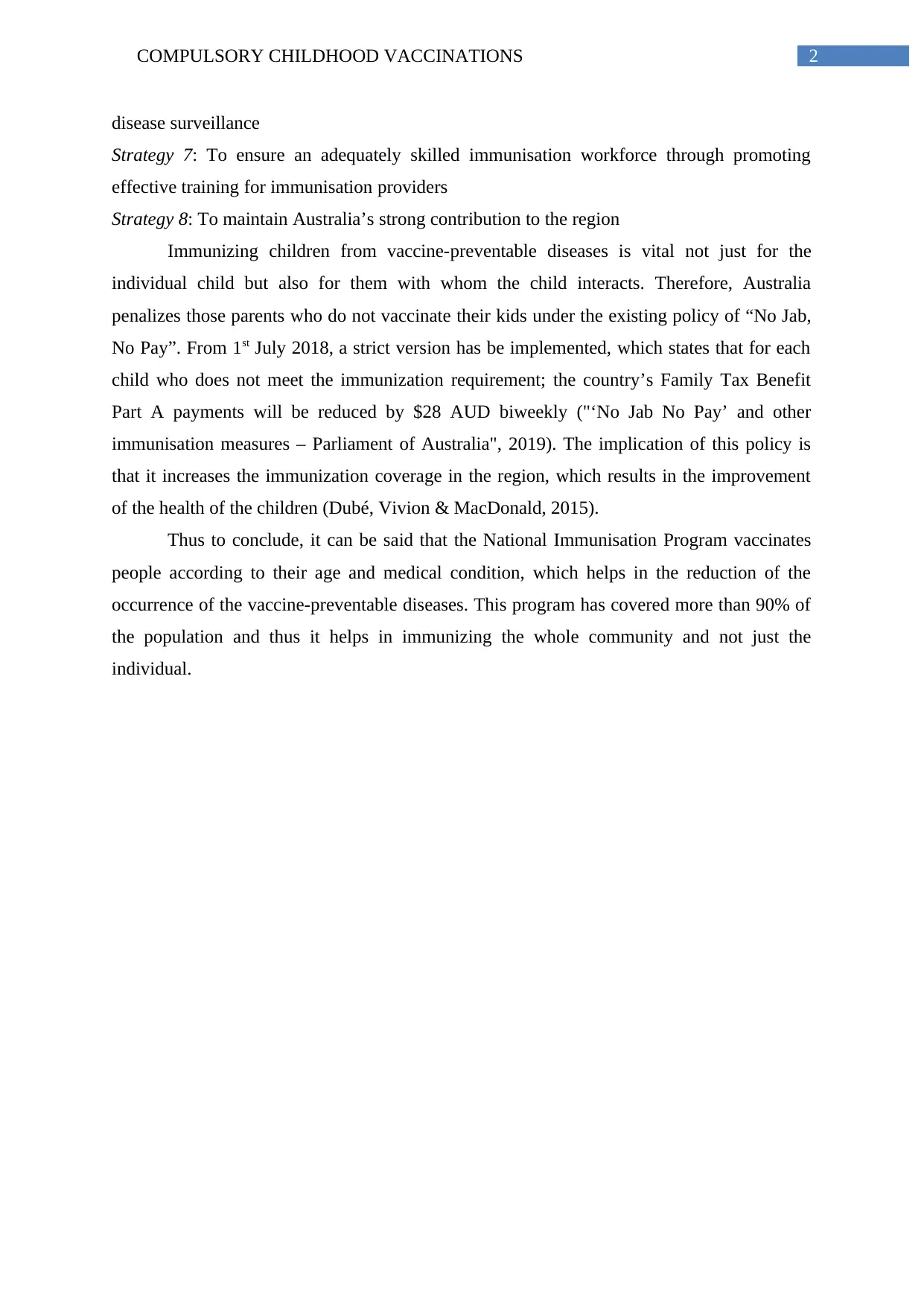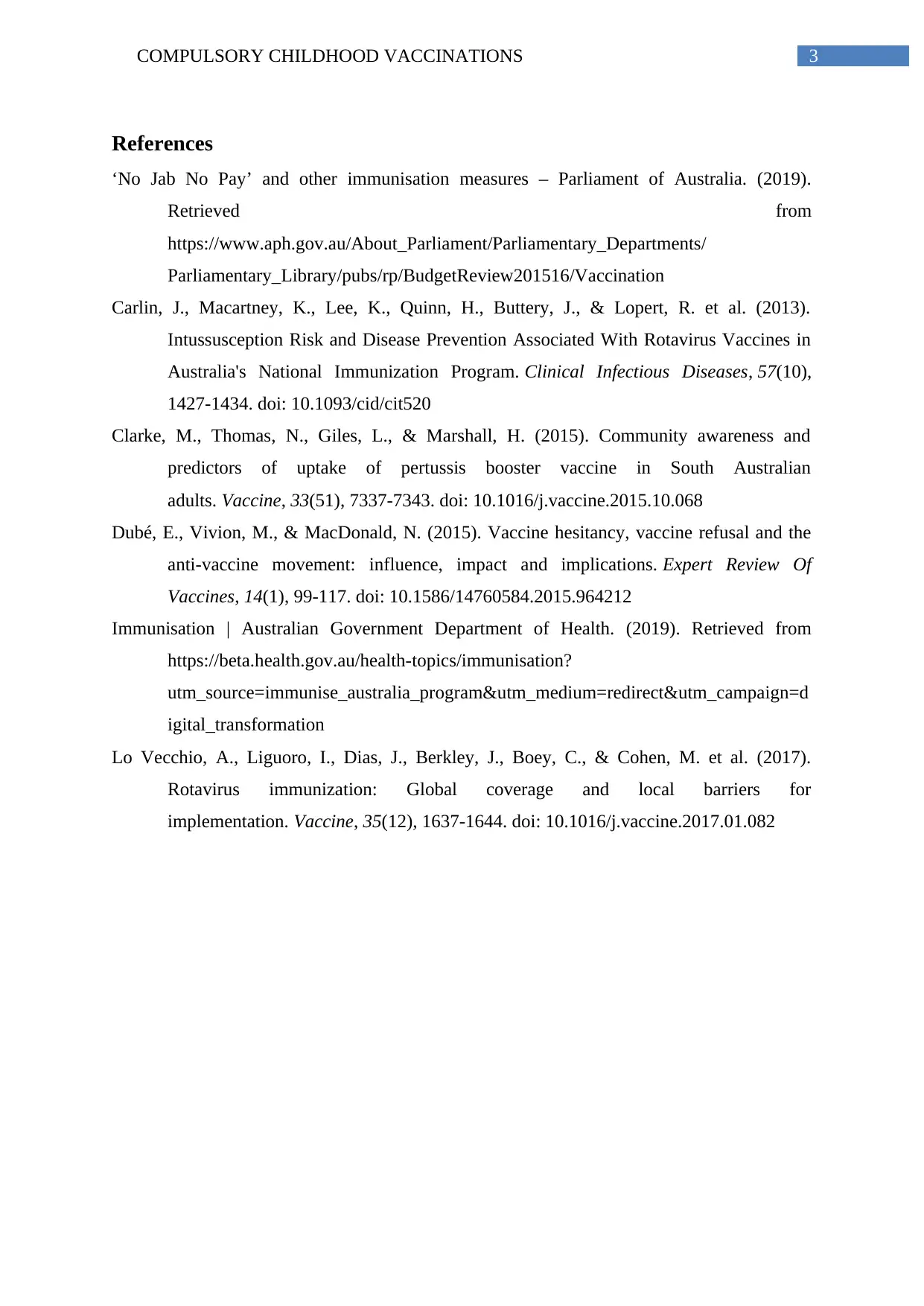Report: Compulsory Childhood Vaccinations in Australia
VerifiedAdded on 2023/04/10
|4
|813
|476
Report
AI Summary
This report provides a comprehensive analysis of Australia's compulsory childhood vaccination policy, focusing on the National Immunization Program (NIP). It details the program's objectives, which include reducing vaccine-preventable diseases and increasing immunization coverage. The report examines the NIP's strategies, governance, and the 'No Jab, No Pay' policy, which penalizes parents who do not vaccinate their children. It also discusses the impact of these policies on immunization rates and the overall health of the population. The analysis highlights the importance of vaccination in preventing diseases, reducing mortality rates, and promoting community immunity. The report concludes by emphasizing the success of the NIP in immunizing a significant portion of the population and its contribution to public health.

Running head: COMPULSORY CHILDHOOD VACCINATIONS
COMPULSORY CHILDHOOD VACCINATIONS
Name of the Student:
Name of the University:
Author note:
COMPULSORY CHILDHOOD VACCINATIONS
Name of the Student:
Name of the University:
Author note:
Paraphrase This Document
Need a fresh take? Get an instant paraphrase of this document with our AI Paraphraser

1COMPULSORY CHILDHOOD VACCINATIONS
The focus of the paper is to describe and analyse a policy that protects and promotes
the population health in Australia. The policy that is chosen for this paper is the compulsory
childhood vaccinations. Vaccination is the process of administration of the weakened germs
to develop the immune system to protect children from acquiring disease. The compulsory
vaccination policy will result in the improved health of the children and will also reduce the
mortality rate (Carlin et al., 2013).
The vaccination or immunization is the most vital invention for sustaining improved
public health for the last two centuries by preventing the spread of diseases, which leads to
serious health issues, hospitalization and even death. Vaccination for children is introduced in
the year 1932 in Australia, which reduced the death by 99% ("Immunisation | Australian
Government Department of Health", 2019). The commonwealth and state and territory
governments in the year 1997 started national Immunization Program (NIP). It aims to reduce
the rate of the disease in children, which can be easily prevented by vaccination, thus
increasing the immunisation coverage nationally. NIP is a strongly recognised policy of
Australia, with 90% vaccination rate in children. This high rate of vaccination helps just not
the individual but also the community as a whole. Community immunity helps reduce the
occurrence of rare diseases (Clarke, Thomas, Giles & Marshall, 2015). NIP is series of
immunizations that are provided to the people depending on their age and medical condition.
NIP provides free vaccination and is available for babies, young children, adolescent
and aged people and it also targets people who are at an increased risk of serious harm due to
certain diseases. This policy is a collaborative work, governed by the commonwealth and
government of states and territories. National Immunization Program provides vaccination
for different diseases, which results in the improved health and reduction in the mortality
rates of the Australians (Lo Vecchio et al., 2017).
To maintain and improve the successful delivery of the NIP, few strategies have been
implemented. The National Immunization Strategy 2019-2024 outlines these strategies:
Strategy 1: To improve the immunization coverage
Strategy 2: To ensure the effective governance of the program
Strategy 3: To ensure secure vaccine supply and their efficient use
Strategy 4: To enhance vaccine safety monitoring systems
Strategy 5: To maintain and ensure community confidence in the National Immunisation
Program through effective communication strategies
Strategy 6: To strengthen monitoring and evaluation of the National Immunisation Program
through assessment and analysis of immunisation register data and vaccine-preventable
The focus of the paper is to describe and analyse a policy that protects and promotes
the population health in Australia. The policy that is chosen for this paper is the compulsory
childhood vaccinations. Vaccination is the process of administration of the weakened germs
to develop the immune system to protect children from acquiring disease. The compulsory
vaccination policy will result in the improved health of the children and will also reduce the
mortality rate (Carlin et al., 2013).
The vaccination or immunization is the most vital invention for sustaining improved
public health for the last two centuries by preventing the spread of diseases, which leads to
serious health issues, hospitalization and even death. Vaccination for children is introduced in
the year 1932 in Australia, which reduced the death by 99% ("Immunisation | Australian
Government Department of Health", 2019). The commonwealth and state and territory
governments in the year 1997 started national Immunization Program (NIP). It aims to reduce
the rate of the disease in children, which can be easily prevented by vaccination, thus
increasing the immunisation coverage nationally. NIP is a strongly recognised policy of
Australia, with 90% vaccination rate in children. This high rate of vaccination helps just not
the individual but also the community as a whole. Community immunity helps reduce the
occurrence of rare diseases (Clarke, Thomas, Giles & Marshall, 2015). NIP is series of
immunizations that are provided to the people depending on their age and medical condition.
NIP provides free vaccination and is available for babies, young children, adolescent
and aged people and it also targets people who are at an increased risk of serious harm due to
certain diseases. This policy is a collaborative work, governed by the commonwealth and
government of states and territories. National Immunization Program provides vaccination
for different diseases, which results in the improved health and reduction in the mortality
rates of the Australians (Lo Vecchio et al., 2017).
To maintain and improve the successful delivery of the NIP, few strategies have been
implemented. The National Immunization Strategy 2019-2024 outlines these strategies:
Strategy 1: To improve the immunization coverage
Strategy 2: To ensure the effective governance of the program
Strategy 3: To ensure secure vaccine supply and their efficient use
Strategy 4: To enhance vaccine safety monitoring systems
Strategy 5: To maintain and ensure community confidence in the National Immunisation
Program through effective communication strategies
Strategy 6: To strengthen monitoring and evaluation of the National Immunisation Program
through assessment and analysis of immunisation register data and vaccine-preventable

2COMPULSORY CHILDHOOD VACCINATIONS
disease surveillance
Strategy 7: To ensure an adequately skilled immunisation workforce through promoting
effective training for immunisation providers
Strategy 8: To maintain Australia’s strong contribution to the region
Immunizing children from vaccine-preventable diseases is vital not just for the
individual child but also for them with whom the child interacts. Therefore, Australia
penalizes those parents who do not vaccinate their kids under the existing policy of “No Jab,
No Pay”. From 1st July 2018, a strict version has be implemented, which states that for each
child who does not meet the immunization requirement; the country’s Family Tax Benefit
Part A payments will be reduced by $28 AUD biweekly ("‘No Jab No Pay’ and other
immunisation measures – Parliament of Australia", 2019). The implication of this policy is
that it increases the immunization coverage in the region, which results in the improvement
of the health of the children (Dubé, Vivion & MacDonald, 2015).
Thus to conclude, it can be said that the National Immunisation Program vaccinates
people according to their age and medical condition, which helps in the reduction of the
occurrence of the vaccine-preventable diseases. This program has covered more than 90% of
the population and thus it helps in immunizing the whole community and not just the
individual.
disease surveillance
Strategy 7: To ensure an adequately skilled immunisation workforce through promoting
effective training for immunisation providers
Strategy 8: To maintain Australia’s strong contribution to the region
Immunizing children from vaccine-preventable diseases is vital not just for the
individual child but also for them with whom the child interacts. Therefore, Australia
penalizes those parents who do not vaccinate their kids under the existing policy of “No Jab,
No Pay”. From 1st July 2018, a strict version has be implemented, which states that for each
child who does not meet the immunization requirement; the country’s Family Tax Benefit
Part A payments will be reduced by $28 AUD biweekly ("‘No Jab No Pay’ and other
immunisation measures – Parliament of Australia", 2019). The implication of this policy is
that it increases the immunization coverage in the region, which results in the improvement
of the health of the children (Dubé, Vivion & MacDonald, 2015).
Thus to conclude, it can be said that the National Immunisation Program vaccinates
people according to their age and medical condition, which helps in the reduction of the
occurrence of the vaccine-preventable diseases. This program has covered more than 90% of
the population and thus it helps in immunizing the whole community and not just the
individual.
⊘ This is a preview!⊘
Do you want full access?
Subscribe today to unlock all pages.

Trusted by 1+ million students worldwide

3COMPULSORY CHILDHOOD VACCINATIONS
References
‘No Jab No Pay’ and other immunisation measures – Parliament of Australia. (2019).
Retrieved from
https://www.aph.gov.au/About_Parliament/Parliamentary_Departments/
Parliamentary_Library/pubs/rp/BudgetReview201516/Vaccination
Carlin, J., Macartney, K., Lee, K., Quinn, H., Buttery, J., & Lopert, R. et al. (2013).
Intussusception Risk and Disease Prevention Associated With Rotavirus Vaccines in
Australia's National Immunization Program. Clinical Infectious Diseases, 57(10),
1427-1434. doi: 10.1093/cid/cit520
Clarke, M., Thomas, N., Giles, L., & Marshall, H. (2015). Community awareness and
predictors of uptake of pertussis booster vaccine in South Australian
adults. Vaccine, 33(51), 7337-7343. doi: 10.1016/j.vaccine.2015.10.068
Dubé, E., Vivion, M., & MacDonald, N. (2015). Vaccine hesitancy, vaccine refusal and the
anti-vaccine movement: influence, impact and implications. Expert Review Of
Vaccines, 14(1), 99-117. doi: 10.1586/14760584.2015.964212
Immunisation | Australian Government Department of Health. (2019). Retrieved from
https://beta.health.gov.au/health-topics/immunisation?
utm_source=immunise_australia_program&utm_medium=redirect&utm_campaign=d
igital_transformation
Lo Vecchio, A., Liguoro, I., Dias, J., Berkley, J., Boey, C., & Cohen, M. et al. (2017).
Rotavirus immunization: Global coverage and local barriers for
implementation. Vaccine, 35(12), 1637-1644. doi: 10.1016/j.vaccine.2017.01.082
References
‘No Jab No Pay’ and other immunisation measures – Parliament of Australia. (2019).
Retrieved from
https://www.aph.gov.au/About_Parliament/Parliamentary_Departments/
Parliamentary_Library/pubs/rp/BudgetReview201516/Vaccination
Carlin, J., Macartney, K., Lee, K., Quinn, H., Buttery, J., & Lopert, R. et al. (2013).
Intussusception Risk and Disease Prevention Associated With Rotavirus Vaccines in
Australia's National Immunization Program. Clinical Infectious Diseases, 57(10),
1427-1434. doi: 10.1093/cid/cit520
Clarke, M., Thomas, N., Giles, L., & Marshall, H. (2015). Community awareness and
predictors of uptake of pertussis booster vaccine in South Australian
adults. Vaccine, 33(51), 7337-7343. doi: 10.1016/j.vaccine.2015.10.068
Dubé, E., Vivion, M., & MacDonald, N. (2015). Vaccine hesitancy, vaccine refusal and the
anti-vaccine movement: influence, impact and implications. Expert Review Of
Vaccines, 14(1), 99-117. doi: 10.1586/14760584.2015.964212
Immunisation | Australian Government Department of Health. (2019). Retrieved from
https://beta.health.gov.au/health-topics/immunisation?
utm_source=immunise_australia_program&utm_medium=redirect&utm_campaign=d
igital_transformation
Lo Vecchio, A., Liguoro, I., Dias, J., Berkley, J., Boey, C., & Cohen, M. et al. (2017).
Rotavirus immunization: Global coverage and local barriers for
implementation. Vaccine, 35(12), 1637-1644. doi: 10.1016/j.vaccine.2017.01.082
1 out of 4
Related Documents
Your All-in-One AI-Powered Toolkit for Academic Success.
+13062052269
info@desklib.com
Available 24*7 on WhatsApp / Email
![[object Object]](/_next/static/media/star-bottom.7253800d.svg)
Unlock your academic potential
Copyright © 2020–2025 A2Z Services. All Rights Reserved. Developed and managed by ZUCOL.





